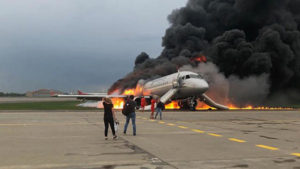
A lot has been said about passengers stopping to collect their cabin bags while escaping the blazing Aeroflot aircraft in Moscow last week. Some media went as far as blaming them for excessive deaths of those trapped behind them, with certain Russian politicians even urging to initiate criminal proceedings against those who stopped to pick their bags up (yes, in Russia, party still goes to you © Yakov Smirnoff).
The moral perspective of this complicated matter is unlikely to ever have any kind of satisfactory resolution. It goes deep into the pre-social parts of our brain, mostly cared for by instincts, reflexes, and fight-or-flight responses – and nature is extremely difficult to judge. In the moments of extreme stress and imminent risk of death, few people would think of anything other than their own salvation. The extent of that few depends on many factors, with different social groups balancing fight, flight, and collaborate differently, but it is crystal clear that we can’t blame people for acting selfishly when their lives are in danger.
That being said, there is no doubt that the problem must be dealt with, for the sake of our own future, first of all. Obviously, the collection of cabin bags did delay the evacuation (though the extent of its contribution is yet to be assessed – and I hope it will be assessed). Yet, what’s more important, is that should a similar accident happen again, in whatever town or country it might take place, the behaviour patterns of the escaping passengers are very likely to be highly similar to what we’ve observed in Sheremetyevo.
The fact is, the safety rules around hand luggage, both written and unwritten, are quite relaxed. Effectively, you can do whatever you like with your bags while on board as long as they fit into the airline’s allowance and don’t contain prohibited items. While pre-flight safety briefings advise you against taking your cabin bags with you during evacuation, this is hardly being enforced. It might be hard to resist the temptation to grab the bag that contains valuables such as your passport, phone, or laptop.
One of the reasons for that is that over the last few decades the role and concept of cabin luggage significantly changed – while the rules governing it remained largely the same. For the vast share of today’s passengers, their cabin bags are their primary and only luggage, especially on short-haul flights. It differs drastically from what it used to be twenty years ago, when most of carry-on items were jackets, overcoats, clutches, and an odd duty free bag, with the principal luggage checked into the aircraft hold. The hold itself acted as a physical security control: in case of an emergency, there was no way for the passengers to retrieve their bags. The small or useless carry-on items didn’t pose any risk of a slowdown during the evacuation. Conversely, most of hand luggage items today are stuffed-to-capacity purpose-made ‘cabin bags’, designed and manufactured specifically to ‘just fit’ into the measuring cages. This makes a huge difference, and this is the problem that must be addressed in the safety rules.
The abundance of bulky personal items on board the aircraft is even more complicated by the fact that with many airlines you can’t bring two cabin bags on board, however small the second one is. This forces you to fit everything you need to take with you into that single piece, mixing items of low and high value in one huge cabin suitcase. Should you need to evacuate, even if you would only intend to grab the high-value items, you would have no other option but to take the bulky low-value ones with you too.
So we need to find a convenient way to address those matters. We can’t make people not care about what they value (e.g. their passport) – but we can totally help them with leaving whatever they value less behind. For example, we could give the cabin crew the powers to lock the overhead cabin bag compartments for the whole duration of the flight, and at the same time extend the hand luggage policy to include a [much] smaller second bag. This second bag could be as small as a clutch, a belt bag, or a neck pouch – just enough to accommodate your passport, phone, and wallet.
Such approach would let passengers separate their items of importance (which in most cases are quite compact in size) from the less significant ones. It would introduce a security control in the form of a lockable overhead compartment, yet give passengers peace of mind that the items they value won’t be lost or destroyed should they need to evacuate.
One way or another, one thing that can be said for sure is that the question of aircraft evacuation and the role of hand luggage in it should not be shelved. The lessons of the Aeroflot crash should be learned, in particular in respect of hand luggage policies and procedures. We would be complete fools if we fail to admit the obvious and simply transfer the blame onto the survivors – since this would mean transferring the punishment onto our future selves.